With the release of Apple’s Vision Pro, its Micro OLED display technology has caught the attention of many. In fact, global Micro OLED display manufacturers have been working in this field for many years. In recent years, Chinese players have been particularly active in this area.
How have various manufacturers progressed? What products have they launched, and what applications have they achieved? This article aims to provide you with a basic understanding of the global Micro OLED manufacturers' situation.
eMagin
eMagin Corporation was founded in 1996 and is headquartered in New York, the United States. Boasting leading Micro OLED technologies for microdisplays, the company offers world-class services for customers across military, consumer, medical and industrial markets. Since 2001, eMagin’s microdisplays have been applied to AR/VR, airplane cockpits, HUD systems, infrared cameras and future weapon systems among many other applications. The company’s most advanced plant—located at Hopewell Junction, New York—boasts a manufacturing base of >3,900 m2, including a Class 10 cleanroom occupying an area of 1,580 m2. In 2022, eMagin reported a revenue of $30.50 million with the rising demand for commercial microdisplays.
In May 2023, eMagin reached an M&A agreement with Samsung Display, after which Samsung acquired it for $218 million.
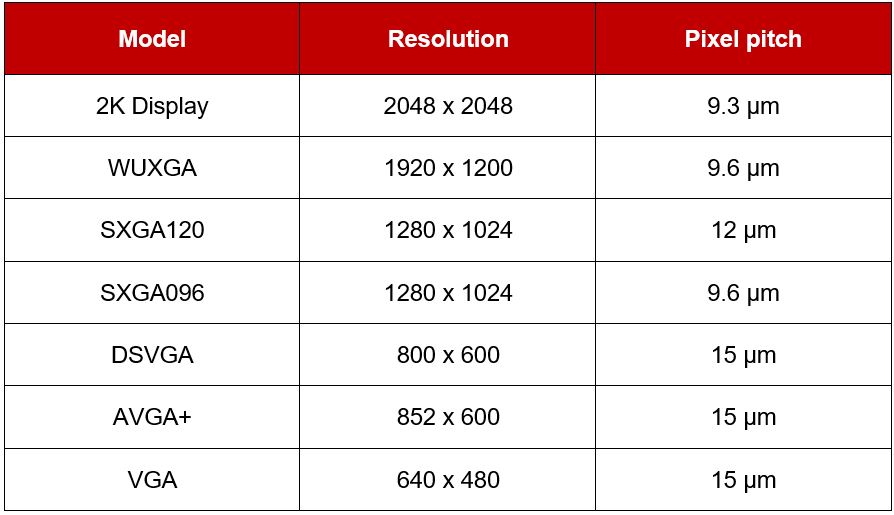
Summary of Micro OLED products made by eMagin (Source: company website)
Olightek
Founded in 2008 in Kunming of Yunnan Province (China), Olightek specializes in manufacturing and marketing AMOLED microdisplays.
On May 14, 2009, Olightek fabricated its first full-color OLED microdisplay sample after integrating all the manufacturing processes. The product’s leading position in the world was further validated through successful technical verification. In March 2010, a small batch of qualified products were subjected to trial production. Entering 2014, the company turned profitable for the first time and continued to go public on NEEQ (a Chinese over-the-counter system) in November 2015. Olightek managed to earn more than 100 million yuan in sales revenue for 2017.
Through continuous innovation and hard effort, Olightek can produce and sell AMOLED microdisplays in batches, helping China become the second country following the US that is capable of AMOLED research, development, and mass production. The company now offers various colored, white and bright green product lines and modules featuring WVGA/SVGA/SXGA resolutions, which have been widely applied to observational, head-mounted display, monitoring, and simulation training systems as well as sectors of industrial testing, medical equipment, AR/VR/MR, and consumer electronics.
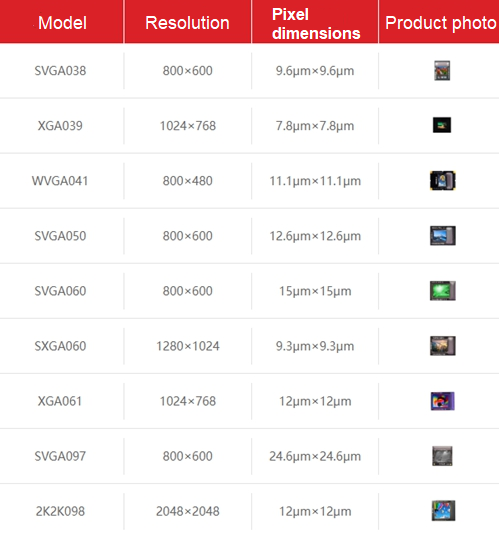
Summary of Micro OLED products made by Olightek (Source: company website)
Sony
In June 2023, Apple announced the Vision Pro headset equipped with two Micro OLED displays made by Sony. Each display measures 1.42 inches with a resolution of 3648×3144, pixel density of 3391ppi, and module brightness of up to 6,000 nits. Reportedly, the exorbitant high-specs Micro OLED screen costs around $350. Sony’s capacity of producing this display is limited, with 900,000 pcs per year at most.
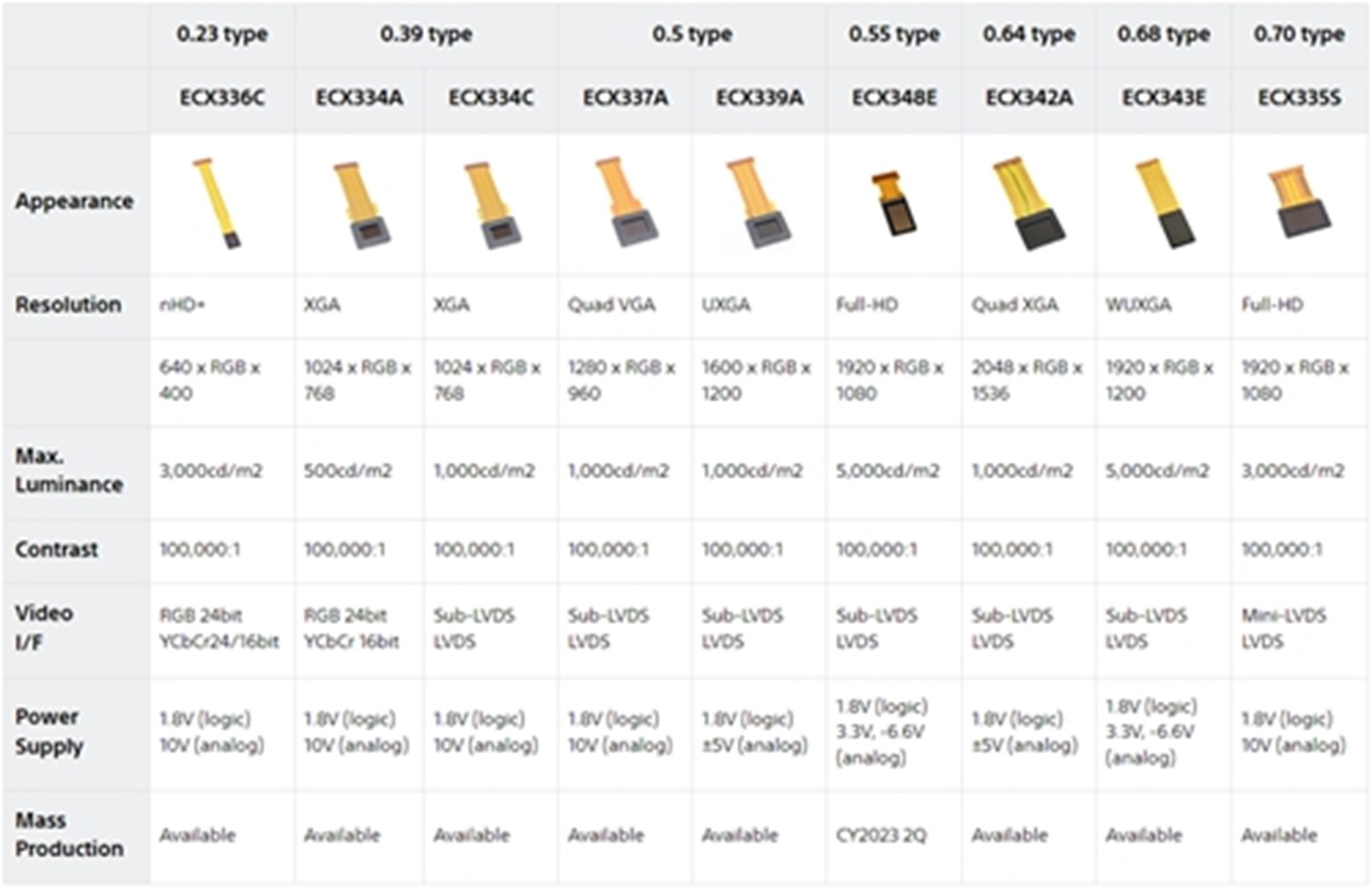
Summary of Micro OLED products made by Sony (Source: SSSG’s website)
MICROOLED
MICROOLED was founded in 2007 and headquartered in Grenoble, France. The firm is dedicated to the research, development, and manufacturing of high-resolution OLED microdisplays. In January 2012, it announced the very first 0.61-inch microdisplay with a resolution of 5.4 million pixels. In August of the same year, STMicroelectronics invested €6 million in MICROOLED, along with a partnership deal signed between the two. In 2015, MICROOLED claimed to have sold more than 150,000 pcs of its 0.38-inch WVGA microdisplays. In 2020, the company announced it had raised €8 million for the research and development of consumer AR solutions.
KOPIN
Founded in 1984 and headquartered in Westborough, Massachusetts, Kopin Corporation has been providing LCD, LCoS and OLED microdisplays for military, business, industrial, medical, and consumer wearable use since 1990.
In March 2023, Kopin announced a critical breakthrough in the development of an OLED microdisplay for the F-35 Joint Strike Fighter Helmet Mounted Display System (HMDS); Kopin also completed performance validation for the OLED microdisplay.
The French business was engaged in the founding of Micro OLED suppliers in China, such as that of Kunming BOE Display Technology (now known as “Yunnan Invensight Optoelectronics Technology”) and Lakeside Optoelectronic Technology (Jiangsu).

Summary of Micro OLED products made by Kopin (Source: company website)
BOE
On August 22, 2017, BOE announced a plan to cooperate with Olightek, Dianzhong Industrial Development Group, and Kopin, whereby they will jointly spend 1.15 billion yuan on building the largest production line of OLED microdisplay components in Kunming, Yunnan Province of China. Specifically, BOE founded Kunming BOE Display Technology, Co. Ltd. (now known as “Yunnan Invensight Optoelectronics Technology Co., Ltd. ”) to focus on the manufacturing, marketing, research and development of OLED components for microdisplays.
On December 26, 2019, BOE proceeded to announce a plan to enhance its competitiveness in the high-end AR/VR market by investing 340 million yuan in establishing production lines for 12-inch OLED microdisplay components. The construction enables the manufacturer to produce 10,000 twelve-inch wafers per month. Major products include 0.99- and 1.31-inch OLED microdisplay components.
In March 2021, BOE revealed on its investor interaction platform that “Invensight managed to mass produce 8-inch Si-based Micro OLEDs in August 2019, while the production capacity is now growing. The new production line of 12-inch Micro OLEDs will be built in three phases, all of which will be accomplished in January 2024. Its production capacity is set at 5.23 million pcs/year.”
The Chinese company unveiled a 1.3-inch 4K (3552×3840) Micro OLED display during the SID Display Week event held in May 2023.
SeeYA Technology
SeeYA Technology was founded in October 2016. In September 2017, the company founded Hefei Seeya Display Co., Ltd. in the Hefei National High-tech Industry Development Zone with a total investment of more than 2 billion yuan. Specifically, the first-stage construction of its manufacturing base, worth 1.28 billion yuan, occupies an area of 55 mu (9.06 acres) with buildings totaling 43,000 m2 (investment in fixed assets exceeded 1 billion yuan). The manufacturing base focuses on the research, development and manufacturing of Si-based OLED microdisplay components fabricated using 12-inch wafers. After the first-stage construction was completed, the monthly wafer starts amounted to 9,000 pcs. Hefei Seeya’s manufacturing base was officially put into operation on November 21, 2019.
A year later (November 2020), Hefei Seeya announced the delivery of its first mass production order.
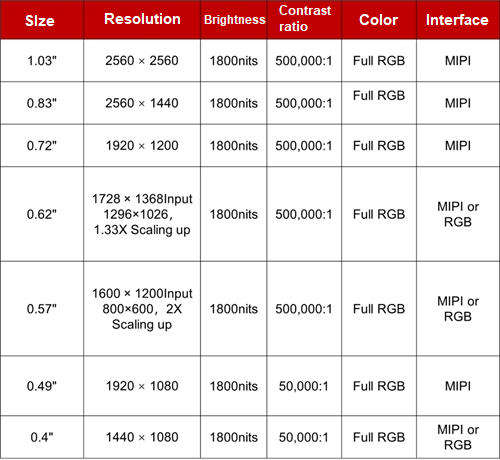
Summary of Micro OLED products made by SeeYA Technology (Source: company website)
On August 25, 2022, DJI, a company focusing on developing innovative drone and camera technologies, unveiled the world’s first consumer flying smart glasses, the FPV Goggles 2, which comes with the 0.49” 1920x1080 OLED microdisplay designed and made by SeeYA.

Mengxian Electronics
Kunshan Mengxian Electronics Technology Co., Ltd. is a subsidiary founded by Qingque Technology (formerly known as “Kunshan Visionox”) in 2018. According to the pre-EIA public document titled “OLED Microdisplay Production Project of Kunshan Mengxian Electronics Technology,” the company made an investment totaling 360 million yuan to produce OLED microdisplays, including purchases of large evaporation equipment and cleaning machines. The project, which was put into operation in June 2020, has helped boost the company’s annual production capacity of OLED microdisplays to 60,000 pcs (large pieces). As Qingyue’s 2022 annual report revealed, Mengxian has been mass producing 8-inch wafers for Si-based OLED microdisplays and delivering them to its customers since 2022, reporting a total of 18 million yuan in revenue for the year.
KT&T
KT&T was founded in 2020. As public information indicates, the company was responsible for a major production base at the uNEED (ultra-high pixel density for near eye display) headquarters of INT. This base, with a total investment of 10 billion yuan, occupies an area of roughly 660 mu (108.7 acres) and was built in two phases. The first-phase project comprised an investment of 1 billion yuan, aiming to satisfy the demand for 5G services. After being built, the production base would offer AMOLED microdisplays featuring ultra-high pixel density for AR/VR devices. On August 10, 2021, KT&T launched the manufacturing of module components.
On its website, KT&T claims that the uNEEDXRTM technology comes with the proprietary technology for RGB self-emitting Si-based OLED microdisplays, instead of following the conventional OLED display structure comprising white diodes covered with colored membranes. uNEEDXRTM technology enables the display to achieve ultra-high pixel density of 3,147 PPI, high brightness exceeding 5,000 nits, color saturation surpassing NTSC100% and contrast ratio of over 2,000,000:1), all while maintaining low power consumption below 500mW at 5000 nits.
SIDTEK
Founded in 2016, SIDTEK is located in Wuhu of Anhui Province, China. The business endeavors to provide high-quality Si-based OLED microdisplays and relevant technical support for customers worldwide.
On November 14, 2022, Wuhu Microdisplay Smart Technology, a subsidiary of SIDTEK, held an open ceremony to celebrate the completion of its manufacturing base producing modules for 12-inch Si-based OLED microdisplays. The base will have a monthly production capacity of 18,000 large 12-inch wafers for the manufacturing of OLED microdisplays and modules. The plant is expected to produce the first product in late 2023. The completion of the manufacturing base means that SIDTEK will be able to produce both 8- and 12-inch microdisplays as well as relevant modules.
SIDTEK presented various OLED microdisplays at the SID WEEK event held in May 2023. Its latest product is a 1.03-inch microdisplay featuring a resolution of 2560×2560, standard MIPI interface and brightness of over 2,500 nits, which consumes 40% less energy compared to products with the same size and brightness.
Additionally, the exhibitor showcased its 0.49-inch (1920×1080), 0.39-inch and 0.6-inch Micro OLED displays. SIDTEK is now developing a high-performance 0.49-inch model as well as 1.2-inch 4K, 1.42-inch and 1.7-inch products, all of which are scheduled to be released between 2H23 and 2024.
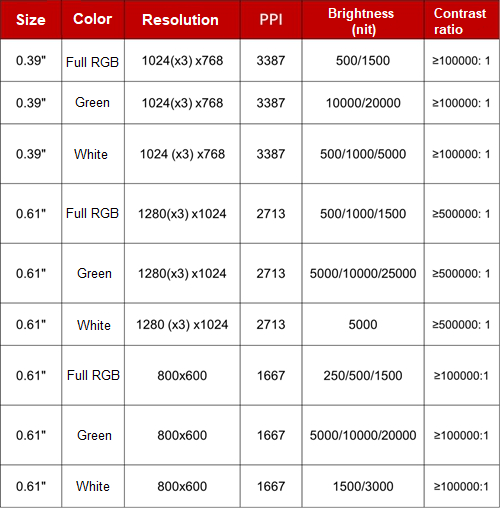
Summary of Micro OLED products made by SIDTEK (source: company website)
Guo Zhao Optoelectronics
Founded in 2019, Guo Zhao Optoelectronics focuses on developing Si-based OLED microdisplays and modules. According to a report titled “Environmental Inspection of a Completed Project with Annual Production Capacity of 500,000 Si-based OLED Microdisplays” published in 2021, Guo Zhao spent 260 million yuan in constructing a production line of Si-based OLED microdisplays, enabling the manufacturing of 500,000 Si-based OLED microdisplays every year.
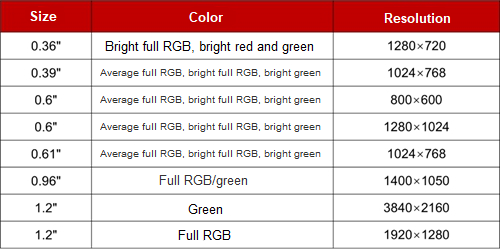
Summary of Micro OLED products made by Guo Zhao Optoelectronics (source: company website)
Metaways
Metaways was founded in 2019 and specializes in the research, development, design, and manufacturing of Si-based OLED microdisplays and modules. Headquartered in the Yiwu Economic-technological Development Area, the company is part of the Project of National Mid- and Small-sized Tech Enterprises in China, Zhejiang Province Pilot Industry Project and Jinhua IC Development Project.
On February 7, 2023, Metaways constructed a production line of 12-inch Si-based OLED microdisplays, after which mass production was kicked off. With self-developed IC design expertise, the manufacturer has developed various Micro OLED models including a 0.6-inch mass produced product. FHD and 4K displays will soon be announced.

Summary of Micro OLED products made by Metaways (source: company website)
Rayvision Technology
Nanjing Rayvision Technology was founded in March 2019 and specializes in the research and development of OLED microdisplay chips. Its subsidiary, Guangxi Rayvision Technology based in the Guangxi Free Trade Zone, was founded in August 2021 with product design and research offices across North America, Shanghai and Shenzhen. Its production lines are located in the China-Malaysia Qinzhou Industrial Park (Guangxi Province, China). The company focuses on the research, development, manufacturing and marketing of OLED microdisplays.
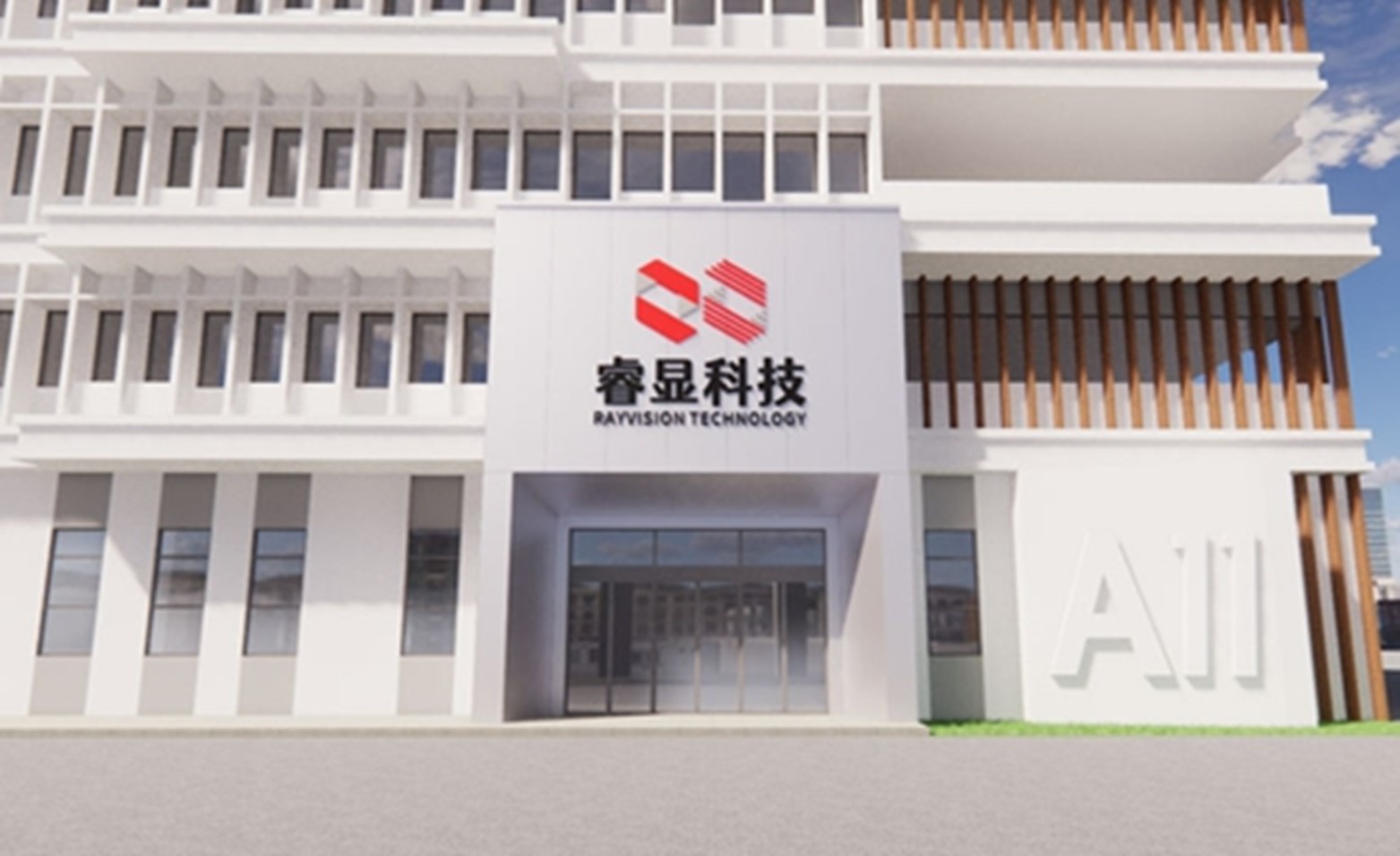
In April 2022, Rayvision’s subsidiary in Guangxi launched a plan to construct an industrialization project for microdisplay chips at Gangpian District in Qinzhou. Specifically, the company intends to spend 300 million yuan in total to build an 8,000-m2 manufacturing base comprising a production line of 8-inch OLED microdisplay chips with a capacity of 400,000 chips per year. Construction of the base was launched on March 30, 2023.
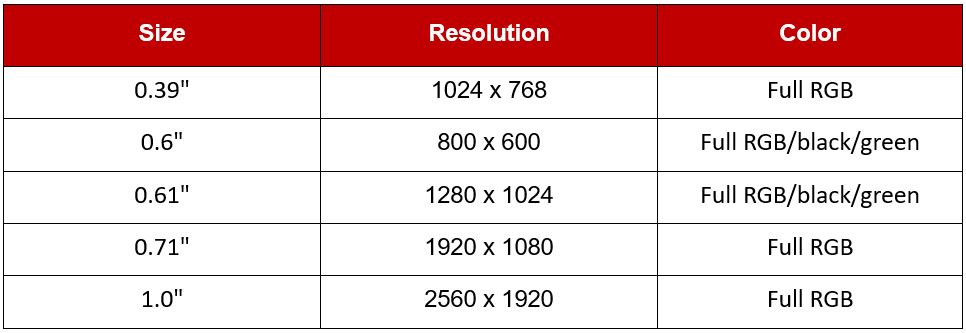
Summary of Micro OLED products made by Rayvision Technology (source: company website)
Lakeside Optoelectronics
Lakeside Optoelectronics (Jiangsu) was founded in April 2017. On May 24, 2023, the manufacturer kicked off the construction of a production base for 12-inch Si-based OLED microdisplays featuring UHD and high brightness at the China Yixing Industrial Park for Environmental Protection. The company would spend a total of 5 billion yuan in the production base, with 3 billion yuan for the first-phase construction. The production base will occupy an area of approx. 100,000 m2. In addition to smart ultra-cleanrooms, production supplementary facilities and general office buildings, the construction project mainly comprises the establishment of two production lines of 12-inch Si-based OLED displays and one research and development line. The production base is scheduled to be built in late 2023, while the said smart cleanrooms will be built in June 2024, after which relevant equipment will be installed. The base is set to launch trial production starting in 4Q24.
The production base will also focus on manufacturing 1.31-inch Si-based microdisplay products with low power consumption and high resolution. Lakeside plans to boost its production capacity to at least 9 million diodes per year within 3 years.
In May 16, 2023, Lakeside Lighting Semiconductor (Lakeside’s subsidiary) announced a partnership with Panasonic. Before this deal, the company had established a long-term strategic partnership with Panasonic and US-based Lighting Silicon. Panasonic’s next-gen smart VR glasses, the MeganeX, are equipped with the third-gen Micro OLED display made by Lakeside, which will be available in 2023.

Summary of Micro OLED products made by Lakeside Optoelectronics (source: company website)
BCDTEK
Founded in 2020, Shenzhen Best Chip & Display Semiconductor Technology (BCDTEK) centers on the research, development and manufacturing of innovative Si-based OLED IC design and OLED microdisplays.
In September 2022, BCDTEK launched the construction of a manufacturing base of Micro OLED modules in Huainan of Anhui Province, China. The project, with a total investment of 100 million yuan, covers the establishment of 3,000-m2 cleanrooms and focuses on production of Si-based OLED microdisplays, flexible OLED smartphone screens and automotive display modules. Expected to create an annual output of ≥200 million yuan, the manufacturing base has been put into operation.
On June 17, 2023, BCDTEK launched the construction of a 12-inch Si-based OLED industrial park in the Huainan High-tech Industry Development Zone (Anhui Province), totaling an investment of 6.5 billion yuan (1.5 billion yuan for first-phase construction) with an area of 198.7 mu (32.7 acres). Its monthly capacity is estimated to reach 4,000 wafers, mostly for the manufacturing of Si-based OLED microdisplays in the AR/VR sector with an annual output of 3.5 billion yuan. After the two-phase construction is completed, the total output is expected to hit 10 billion yuan or more. The production base is scheduled to be equipped with relevant equipment starting in July 2024, put into operation in December, and kick off mass production in 2025.

Summary of Micro OLED products made by BCDTEK (source: company website)
LumiCore
Nanjing LumiCore Co., Ltd. was founded in 2019 and owns a system capable of the design, research and development of display driver ICs as well as the manufacturing and testing of OLED microdisplays. The company has developed a 2.5K×2.5K UHD Si-based OLED microdisplay.
ChinaRay
As EIA documents reveal, Guangzhou ChinaRay Optoelectronic Materials, Co., Ltd., a subsidiary of TCL, focuses on producing components for AR and VR devices regarding its Si-based OLED microdisplay project. It is able to produce 24,000 wafers and 600,000 dies for such display components every year.
Ascending Optronics (AOL)
Ascending Optronics (Suzhou) Co., Ltd. (AOL) was founded in 2020. In December 2020, the management committee of the Shandong Zibo High-Tech Zone signed an agreement with AOL to build a manufacturing base of Si-based OLED microdisplays, which will be completed in three phases with a total investment of 1.45 billion yuan.
SMARTVISION
SMARTVISION was founded in 2017, with the management team being formed as early as 2012. Its major products include Si-based LCoS microdisplay chips, Si-based OLED microdisplay chips, Si-based Micro LED display chips and spatial light modulators.
Samsung Display
In early 2022, Samsung Display revealed that it had just started developing a Micro OLED display. The display maker planned to construct the first production line in 2023 and mass produce the device in 2024. Additionally, Samsung decided to expand its production capacity in 2025 to facilitate full commercialization in 2026.
In December 2022, the South Korean media reported that Samsung has begun ordering equipment for mid-scale trial production of the 300-mm model, with SFA Engineering and AP Systems being the equipment suppliers. The production line was located at the company’s A2 plant in Asan, South Korea. The electronics giant has requested delivery of the first equipment in 1Q23 before it starts mass producing the Micro OLED display in late 2023. The production capacity is set to 6,400 wafers per month, and full-scale production would kick off in 2024.
In May 2023, eMagin and Samsung Display finalized their merger and acquisition agreement, with Samsung Display acquiring eMagin for a total of $218 million.
LG Display
In February 2023, the South Korean media reported that Meta will partner with SK Hynix and LG Display to co-develop a Micro OLED display for AR/VR headsets. Specifically, Meta will be responsible for semiconductor design, while SK Hynix focuses on wafer production. LG Display will then deposit the OLEDs on wafers and complete the final step by cutting them into the Micro OLEDs attached to panels.
Reportedly, the Icheon headquarters of SK Hynix in Gyeonggi Province, South Korea comprise three DRAM production lines, namely the M10, M14 and M16 production lines. The manufacturer plans to produce wafers for Micro OLED displays using the M10 line based on 12-inch wafers with a monthly capacity of 100,000 pcs. If the product development goes smoothly, production of 30,000 units per month is expected to commence in 2025-2026. Additionally, the development team expects to utilize the 28nm or 45nm process for manufacturing Micro OLED wafers.
Epson
Epson has conducted nearly 20 years of research in OLED-related technologies and has introduced multiple Micro OLED smart glasses. Epson’s VM-40 AR optical module features a 0.453-inch 1920 x 1080 Micro OLED screen.
Fraunhofer FEP
The Fraunhofer Institute for Organic Electronics, Electron Beam and Plasma Technology FEP (Fraunhofer FEP) is a leading international research institution dedicated to the development of electron beam and plasma technologies, as well as processes and technologies in the organic electronics and optoelectronics sectors.
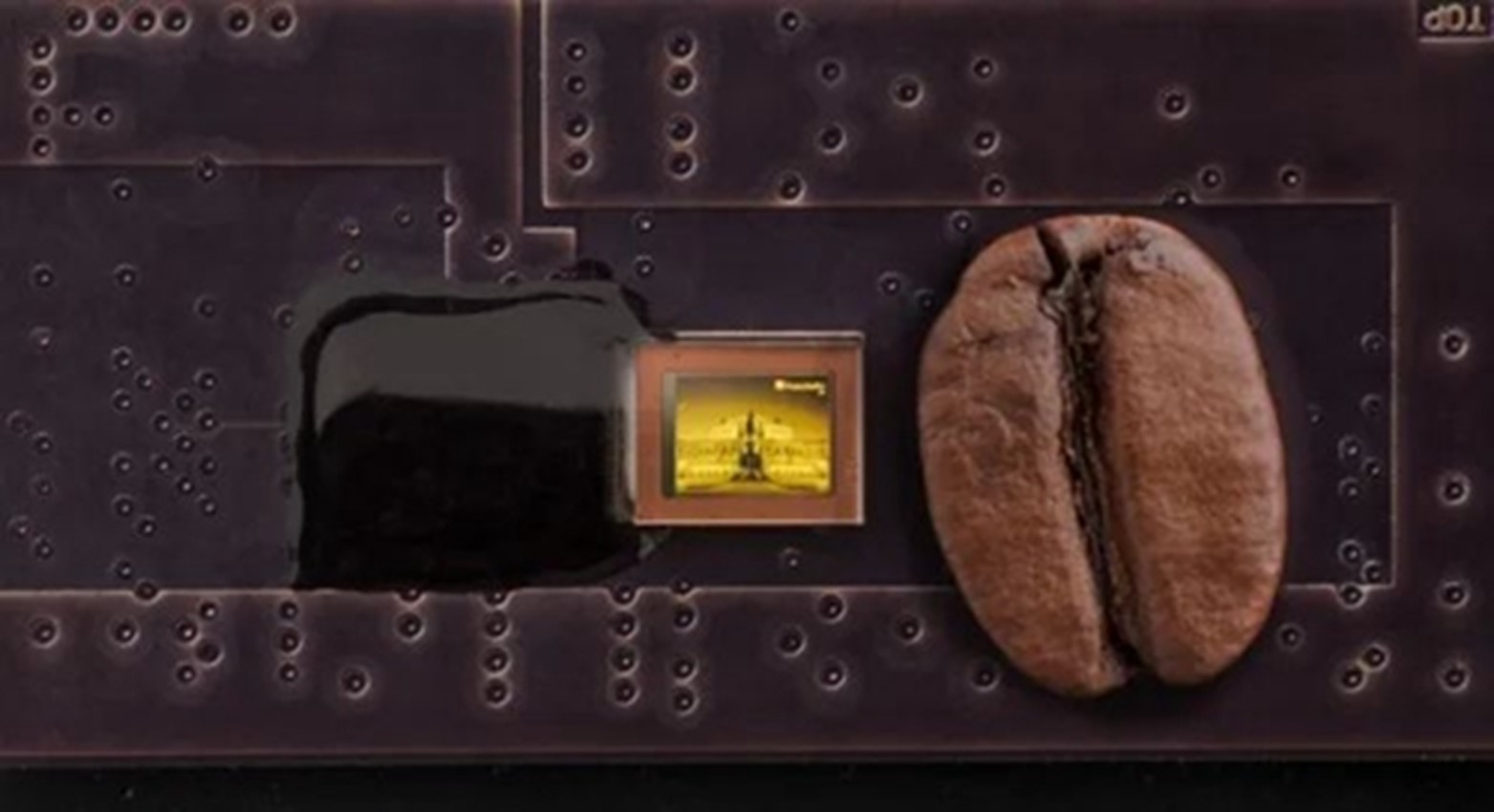
OLED microdisplay with a pixel size of 2.5μm and resolution of 1440*1080
In 2021, Fraunhofer FEP announced a dual-color Micro OLED display with a resolution of QVGA 320×240. At SID Display Week 2023, Fraunhofer FEP showcased several microdisplay products, including the latest OLED microdisplay with the world’s smallest pixel size (2.5μm).
Note: The information about Micro OLED products in the text is sourced from the respective manufacturers’ websites. For the latest products, please refer to their latest updates and specifications.
TrendForce 2023 Micro LED Market Trend and Technology Cost Analysis
Release Date: 31 May / 30 November 2023
Language: Traditional Chinese / English
Format: PDF
Page: 160 / Year
【Early Bird Discount】Micro LED: Metaverse X Technological Evolution X Application Innovation
Time:September 5th, 2023
Venue:Room 401, National Taiwan University Hospital International Convention Center, Taipei, Taiwan.
Price:Early Bird Discount USD 230 (until August 25th, 2023, the original price is USD 280)
|
If you would like to know more details , please contact:
|




















